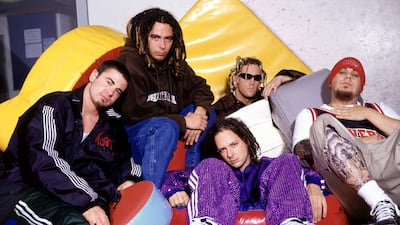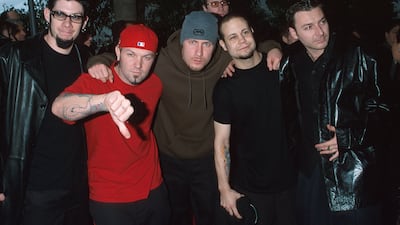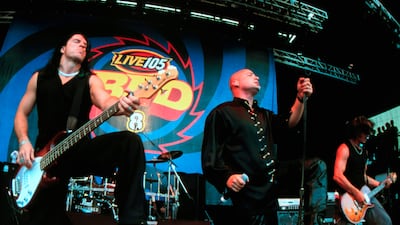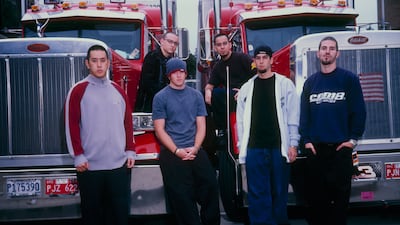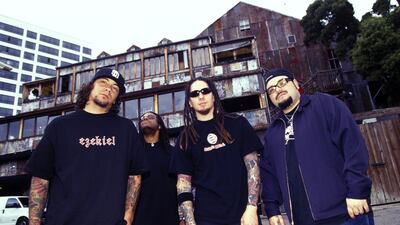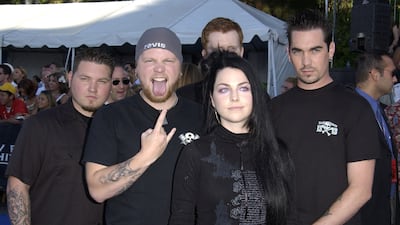Thirty years ago this week a song was released that would go on to kick start a new music genre in the US.
Neidermeyer's Mind, now out of print and released as a demo-tape by fledgling US band Korn, brought a new element to metal music.
There are low-tuned guitars, heavy bass lines and a vocal style by singer Jonathan Davis that combines singing, rapping, metal growling and screaming.
With potent lyrics touching on mental health and alienation, the dark and fiercely vulnerable subject matter was a new element to the metal landscape, one that largely favoured visceral aggression over self-therapy.
The song went on to become the harbinger of a sound called nu-metal, and while it’s unclear who coined the name, it was undeniably one of the most popular genres at the turn of the century.
Here are 10 songs tracking its journey.
1. Blind by Korn (1994)
The lead single from Korn's debut album, Blind is viewed as the first official track to kick off nu-metal.
With all the signature elements refined since that first scratchy demo-tape and the songwriting more pronounced and dynamic, Blind is powerful and utterly cathartic.
2. Wait and Bleed by Slipknot (1999)
The controversial group are a great distillation of nu-metal's visual aesthetics.
The striking jumpsuits and trainers are tied to the genre’s hip-hop influences, while the dark and at times gory clown masks and visuals recall the likes of gloomy metal masters Black Sabbath and Slayer.
On the music front, Slipknot are totally their own.
Wait and Bleed epitomises nu-metal’s mix-and-match approach, taking elements from rock, metal and hip-hop through heavily distorted guitars and guttural vocals in the verse, contrasted with a clean and radio friendly chorus.
It’s as thrilling as it is chaotic, thus underscoring nu-metal’s exciting potential.
3. Break Stuff by Limp Bizkit (2000)
The year 2000 will go down as the one where nu-metal went from a proudly independent movement to a commercial juggernaut.
Leading the charge was Limp Bizkit with their caustic yet exuberant Break Stuff, which would go on to become one of the genre’s defining anthems.
The song’s success is down to the genre-bending the group does so effectively.
Musically led by inventive guitarist and riff-machine Wes Borland and with hip-hop turntablist DJ Lethal on the decks, the band conjure up a sonic fury matching the nihilism of the lyrics.
Then, of course, there is the front man, Fred Durst.
The baseball-cap-wearing singer would go on to epitomise the best and worst qualities of the genre during its heyday, in that he is full of brio, but ultimately has nothing to say.
4. Down with the Sickness by Disturbed (2000)
Where Limp Bizkit were often all about dialling up the energy, nu-metal brethren Disturbed have flair.
Signature hit Down with the Sickness launches with singer David Draiman's guttural chant and the band’s riffs, the drama is then skilfully directed towards an anthemic chorus.
Topping the mainstream rock charts in the US, Down with the Sickness demonstrates how the genre can feature high-quality songwriting.
5. Butterfly by Crazy Town (2000)
Love it or hate it, you can’t deny just how ubiquitous this song was at the time.
While it did go on to render Crazy Town as a one-hit wonder, Butterfly is the nu-metal equivalent of a power ballad.
Hardcore fans cringed at how sappy it was, with some even denying that it was even nu-metal, but Butterfly ticks off all of the genre's core elements, with hip-hop-inspired rapping and sampling, and tasteful rock guitar riffs and bass grooves.
Butterfly shows that the genre is equally adept at speaking about love, as it is about breaking things.
6. One Step Closer by Linkin Park (2000)
A big question and a sour point for fans and artists is, why did Linkin Park take off so immediately?
Was it a matter of timing and their boyband look, or was it down to the pristinely radio-friendly songs and the major record label backing them?
The answer is a bit of everything.
Amid the encroaching saturation of the scene, Linkin Park cherry-picked the best sonic elements of nu-metal and presented them in a non-threatening manner.
One Step Closer is a case in point. Play it loud and it’s a seriously heavy rocker, but it was late singer Chester Bennington's emotional and dynamic delivery that made it appeal to the masses.
In One Step Closer he displays the dynamism that would prove to be the template for future Linkin Park hits like In The End and Numb, with verses sung with the vulnerability of an Nsync record and a snarling chorus recalling the likes of Pantera and Metallica.
Is it all a bit too calculated? Perhaps, but fundamentally it’s just good songwriting and Linkin Park would go on to be the genre’s commercial leaders for years to come.
7. Youth of the Nation by POD (2001)
For a genre grounded in youth culture, it is surprising how most of nu-metal's biggest tracks were often limited to expressions of internal rage and anguish.
POD (full name Payment on Death) shows it can provide a macro look at youth alienation as well as spinning a fine narrative.
Each verse touches on different tragic elements of American youth culture.
Gun violence is highlighted through the story of a teenager skating to school only to be shot by a classmate.
A 12-year-old girl named Suzie finds "love in all the wrong places" due to growing up in a broken home, while peer pressure and loneliness pushes another teen, "Johnny boy", to take his own life.
The sober lyrics, augmented by a subdued musical backdrop and some forceful rapping by frontman Sonny Sandoval, challenged perceptions of what makes nu-metal.
8. Chop Suey! by System of a Down (2001)
While nu-metal’s commercial clout resulted in an avalanche of bands getting signed to major record labels, the genre’s appeal would begin to plateau with its lack of distinctive voices.
Enter System of a Down with their blistering break-out single.
It almost sounds derivative to ascribe their name to a genre, such is their dizzying approach in genre blending and panache for creating memorable melodies over schizoid instrumentation.
Chop Suey is both bonkers and brilliant.
A hip-hop song with a heavy metal heart and vice versa.
It sounds like a riot in a music store but displays the songwriting craftsmanship of seasoned hands and went on to launch the careers of one of rock’s most experimental bands.
9. Bring Me to Life by Evanescence (2003)
Evanescence is another group adding much-needed vibrancy to the increasingly turgid-sounding genre.
At the time, nu-metal was in permanent decline.
Former kings Limp Bizkit’s latest album Results May Vary tanked and Take a Look in the Mirror by originators Korn also disappointed.
At the same time a growing cavalry of garage rockers like The Strokes and White Stripes were on their way to taking over the rock world.
That said, Evanescence showed there was still some life yet in nu-metal with the dramatic Bring Me to Life, which pairs Amy Lee’s operatic vocals with tough staccato riffs and some inane rapping.
Despite scoring a global hit, the band sensed the winds of change and abandoned the genre with future releases.
10. Choose your Fighter by the Nova Twins (2022)
So is nu-metal dead? Well, not so fast.
The genre is making a revival, albeit in a different form and looks.
Where it originally took shape in urban US cities before spreading to Middle America, the nu-metal genre-defying spirit has been channelled by a new generation of artists who grew up on streaming and playlists.
The best of the bunch, which includes the US groups Code Orange and Orthodox, are the Nova Twins.
The UK duo are one of the most exciting rock bands today and have played at most of this year’s major rock festivals including Glastonbury in the UK and Japan’s Fuji Rock.
While their forebears took their cues from graffiti culture and punk, the Nova Twins (whose members Amy Love and Georgia South are both not yet 30) take their influences from social media, gaming and Y2K-era artists No Doubt, Pharrell Williams and Rage Against the Machine.
Choose Your Fighter is an exciting reminder of where nu-metal came from and where it could go.
White hydrogen: Naturally occurring hydrogen
Chromite: Hard, metallic mineral containing iron oxide and chromium oxide
Ultramafic rocks: Dark-coloured rocks rich in magnesium or iron with very low silica content
Ophiolite: A section of the earth’s crust, which is oceanic in nature that has since been uplifted and exposed on land
Olivine: A commonly occurring magnesium iron silicate mineral that derives its name for its olive-green yellow-green colour
box
COMPANY PROFILE
Company name: Letstango.com
Started: June 2013
Founder: Alex Tchablakian
Based: Dubai
Industry: e-commerce
Initial investment: Dh10 million
Investors: Self-funded
Total customers: 300,000 unique customers every month
Islamic%20Architecture%3A%20A%20World%20History
%3Cp%3E%3Cstrong%3EAuthor%3A%3C%2Fstrong%3E%20Eric%20Broug%3Cbr%3E%3Cstrong%3EPublisher%3A%3C%2Fstrong%3E%20Thames%20%26amp%3B%20Hudson%3Cbr%3E%3Cstrong%3EPages%3A%3C%2Fstrong%3E%20336%3Cbr%3E%3Cstrong%3EAvailable%3A%3C%2Fstrong%3E%20September%3C%2Fp%3E%0A
Our legal columnist
Name: Yousef Al Bahar
Advocate at Al Bahar & Associate Advocates and Legal Consultants, established in 1994
Education: Mr Al Bahar was born in 1979 and graduated in 2008 from the Judicial Institute. He took after his father, who was one of the first Emirati lawyers
ORDER OF PLAY ON SHOW COURTS
Centre Court - 4pm (UAE)
Gael Monfils (15) v Kyle Edmund
Karolina Pliskova (3) v Magdalena Rybarikova
Dusan Lajovic v Roger Federer (3)
Court 1 - 4pm
Adam Pavlasek v Novak Djokovic (2)
Dominic Thiem (8) v Gilles Simon
Angelique Kerber (1) v Kirsten Flipkens
Court 2 - 2.30pm
Grigor Dimitrov (13) v Marcos Baghdatis
Agnieszka Radwanska (9) v Christina McHale
Milos Raonic (6) v Mikhail Youzhny
Tsvetana Pironkova v Caroline Wozniacki (5)
Youth YouTuber Programme
The programme will be presented over two weeks and will cover the following topics:
- Learning, scripting, storytelling and basic shots
- Master on-camera presence and advanced script writing
- Beating the algorithm and reaching your core audience
Teaching your child to save
Pre-school (three - five years)
You can’t yet talk about investing or borrowing, but introduce a “classic” money bank and start putting gifts and allowances away. When the child wants a specific toy, have them save for it and help them track their progress.
Early childhood (six - eight years)
Replace the money bank with three jars labelled ‘saving’, ‘spending’ and ‘sharing’. Have the child divide their allowance into the three jars each week and explain their choices in splitting their pocket money. A guide could be 25 per cent saving, 50 per cent spending, 25 per cent for charity and gift-giving.
Middle childhood (nine - 11 years)
Open a bank savings account and help your child establish a budget and set a savings goal. Introduce the notion of ‘paying yourself first’ by putting away savings as soon as your allowance is paid.
Young teens (12 - 14 years)
Change your child’s allowance from weekly to monthly and help them pinpoint long-range goals such as a trip, so they can start longer-term saving and find new ways to increase their saving.
Teenage (15 - 18 years)
Discuss mutual expectations about university costs and identify what they can help fund and set goals. Don’t pay for everything, so they can experience the pride of contributing.
Young adulthood (19 - 22 years)
Discuss post-graduation plans and future life goals, quantify expenses such as first apartment, work wardrobe, holidays and help them continue to save towards these goals.
* JP Morgan Private Bank
World record transfers
1. Kylian Mbappe - to Real Madrid in 2017/18 - €180 million (Dh770.4m - if a deal goes through)
2. Paul Pogba - to Manchester United in 2016/17 - €105m
3. Gareth Bale - to Real Madrid in 2013/14 - €101m
4. Cristiano Ronaldo - to Real Madrid in 2009/10 - €94m
5. Gonzalo Higuain - to Juventus in 2016/17 - €90m
6. Neymar - to Barcelona in 2013/14 - €88.2m
7. Romelu Lukaku - to Manchester United in 2017/18 - €84.7m
8. Luis Suarez - to Barcelona in 2014/15 - €81.72m
9. Angel di Maria - to Manchester United in 2014/15 - €75m
10. James Rodriguez - to Real Madrid in 2014/15 - €75m
Zodi%20%26%20Tehu%3A%20Princes%20Of%20The%20Desert
%3Cp%3E%3Cstrong%3EDirector%3A%20%3C%2Fstrong%3EEric%20Barbier%26nbsp%3B%3C%2Fp%3E%0A%3Cp%3E%3Cstrong%3EStarring%3A%20%3C%2Fstrong%3EYoussef%20Hajdi%2C%20Nadia%20Benzakour%2C%20Yasser%20Drief%3C%2Fp%3E%0A%3Cp%3E%3Cstrong%3ERating%3A%3C%2Fstrong%3E%204%2F5%3C%2Fp%3E%0A
ALRAWABI%20SCHOOL%20FOR%20GIRLS
%3Cp%3ECreator%3A%20Tima%20Shomali%3C%2Fp%3E%0A%3Cp%3EStarring%3A%C2%A0Tara%20Abboud%2C%C2%A0Kira%20Yaghnam%2C%20Tara%20Atalla%3C%2Fp%3E%0A%3Cp%3ERating%3A%204%2F5%3C%2Fp%3E%0A
COMPANY%20PROFILE
%3Cp%3E%3Cstrong%3EDate%20started%3A%3C%2Fstrong%3E%202020%3Cbr%3E%3Cstrong%3EFounders%3A%3C%2Fstrong%3E%20Khaldoon%20Bushnaq%20and%20Tariq%20Seksek%3Cbr%3E%3Cstrong%3EBased%3A%3C%2Fstrong%3E%20Abu%20Dhabi%20Global%20Market%3Cbr%3E%3Cstrong%3ESector%3A%3C%2Fstrong%3E%20HealthTech%3Cbr%3E%3Cstrong%3ENumber%20of%20staff%3A%3C%2Fstrong%3E%20100%3Cbr%3E%3Cstrong%3EFunding%20to%20date%3A%3C%2Fstrong%3E%20%2415%20million%3C%2Fp%3E%0A
THE APPRENTICE
Director: Ali Abbasi
Starring: Sebastian Stan, Maria Bakalova, Jeremy Strong
Rating: 3/5
Tips to keep your car cool
- Place a sun reflector in your windshield when not driving
- Park in shaded or covered areas
- Add tint to windows
- Wrap your car to change the exterior colour
- Pick light interiors - choose colours such as beige and cream for seats and dashboard furniture
- Avoid leather interiors as these absorb more heat
The specs
Engine: 2.0-litre turbo 4-cyl
Transmission: eight-speed auto
Power: 190bhp
Torque: 300Nm
Price: Dh169,900
On sale: now
UAE currency: the story behind the money in your pockets
How to wear a kandura
Dos
- Wear the right fabric for the right season and occasion
- Always ask for the dress code if you don’t know
- Wear a white kandura, white ghutra / shemagh (headwear) and black shoes for work
- Wear 100 per cent cotton under the kandura as most fabrics are polyester
Don’ts
- Wear hamdania for work, always wear a ghutra and agal
- Buy a kandura only based on how it feels; ask questions about the fabric and understand what you are buying
GOLF’S RAHMBO
- 5 wins in 22 months as pro
- Three wins in past 10 starts
- 45 pro starts worldwide: 5 wins, 17 top 5s
- Ranked 551th in world on debut, now No 4 (was No 2 earlier this year)
- 5th player in last 30 years to win 3 European Tour and 2 PGA Tour titles before age 24 (Woods, Garcia, McIlroy, Spieth)
OTHER IPL BOWLING RECORDS
Best bowling figures: 6-14 – Sohail Tanvir (for Rajasthan Royals against Chennai Super Kings in 2008)
Best average: 16.36 – Andrew Tye
Best economy rate: 6.53 – Sunil Narine
Best strike-rate: 12.83 – Andrew Tye
Best strike-rate in an innings: 1.50 – Suresh Raina (for Chennai Super Kings against Rajasthan Royals in 2011)
Most runs conceded in an innings: 70 – Basil Thampi (for Sunrisers Hyderabad against Royal Challengers Bangalore in 2018)
Most hat-tricks: 3 – Amit Mishra
Most dot-balls: 1,128 – Harbhajan Singh
Most maiden overs bowled: 14 – Praveen Kumar
Most four-wicket hauls: 6 – Sunil Narine
Your rights as an employee
The government has taken an increasingly tough line against companies that fail to pay employees on time. Three years ago, the Cabinet passed a decree allowing the government to halt the granting of work permits to companies with wage backlogs.
The new measures passed by the Cabinet in 2016 were an update to the Wage Protection System, which is in place to track whether a company pays its employees on time or not.
If wages are 10 days late, the new measures kick in and the company is alerted it is in breach of labour rules. If wages remain unpaid for a total of 16 days, the authorities can cancel work permits, effectively shutting off operations. Fines of up to Dh5,000 per unpaid employee follow after 60 days.
Despite those measures, late payments remain an issue, particularly in the construction sector. Smaller contractors, such as electrical, plumbing and fit-out businesses, often blame the bigger companies that hire them for wages being late.
The authorities have urged employees to report their companies at the labour ministry or Tawafuq service centres — there are 15 in Abu Dhabi.
Benefits of first-time home buyers' scheme
- Priority access to new homes from participating developers
- Discounts on sales price of off-plan units
- Flexible payment plans from developers
- Mortgages with better interest rates, faster approval times and reduced fees
- DLD registration fee can be paid through banks or credit cards at zero interest rates
The specs
AT4 Ultimate, as tested
Engine: 6.2-litre V8
Power: 420hp
Torque: 623Nm
Transmission: 10-speed automatic
Price: From Dh330,800 (Elevation: Dh236,400; AT4: Dh286,800; Denali: Dh345,800)
On sale: Now
COMPANY%20PROFILE
%3Cp%3E%3Cstrong%3EName%3A%3C%2Fstrong%3E%20Carzaty%2C%20now%20Kavak%3Cbr%3E%3Cstrong%3EBased%3A%3C%2Fstrong%3E%20Dubai%3Cbr%3E%3Cstrong%3ELaunch%20year%3A%20%3C%2Fstrong%3ECarzaty%20launched%20in%202018%2C%20Kavak%20in%20the%20GCC%20launched%20in%202022%3Cbr%3E%3Cstrong%3ENumber%20of%20employees%3A%3C%2Fstrong%3E%20140%3Cbr%3E%3Cstrong%3ESector%3A%3C%2Fstrong%3E%20Automotive%3Cbr%3E%3Cstrong%3EFunding%3A%20%3C%2Fstrong%3ECarzaty%20raised%20%246m%20in%20equity%20and%20%244m%20in%20debt%3B%20Kavak%20plans%20%24130m%20investment%20in%20the%20GCC%3C%2Fp%3E%0A
The Settlers
Director: Louis Theroux
Starring: Daniella Weiss, Ari Abramowitz
Rating: 5/5
Company Profile
Founder: Omar Onsi
Launched: 2018
Employees: 35
Financing stage: Seed round ($12 million)
Investors: B&Y, Phoenician Funds, M1 Group, Shorooq Partners
Mohammed bin Zayed Majlis

